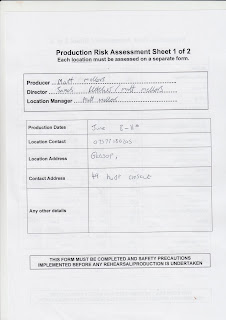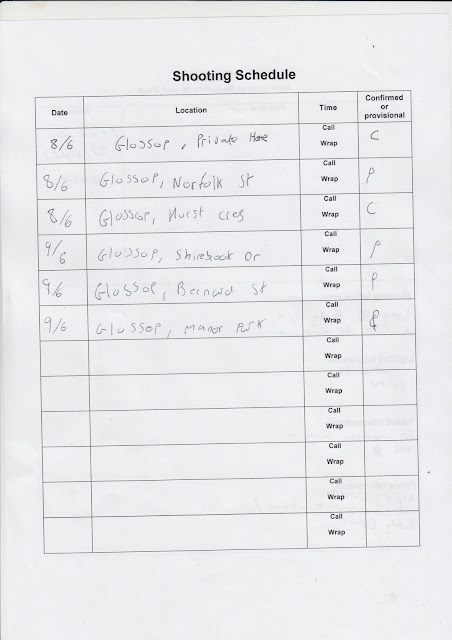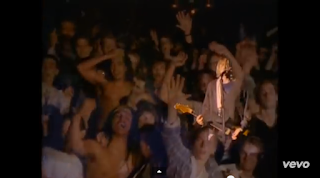Pre-Production
Pre-production is the first and most time consuming of all parts of production. During most industrial or high quality music video on average spend three weeks in pre-production. Because my video was on a lower budget, I spent less time on pre production.
Production Schedule:
The first part of my pre-production was to create a production schedule. My production schedule helps me plan the dates that I during my production to make sure they are completed before the deadline.
Storyboard
The next part of my production was to create a storyboard. The storyboard was created so I could have a visual aspect of the music video, such as the shots used, what audio to use and to discover and pin point the general subject matter and tone of my music video. Storyboards are a vital part of pre-production which is used in every professional video production.
 Risk Assessment
Risk AssessmentThe third task of my pre-production was to create a risk assessment. The risk assessment helps prevent any physical risks that I may encounter during the production stage of my music video. While writing my risk assessment it is important that I consider the possible risks that I could encounter in the location of filming. It is is also essential that I give contact details for the college in case of emergency. Risk assessments are arguably the most vital part of pre production because they examine the safety of the people working on the production.
Call Sheet
The call sheet is a document which is used to document a day's filming. The call sheet is also used as a sign in sheet for the cast and crew in a video production and is used to calculate the cost and time spent on transport and catering. For my music video I had to complete three call sheets because I was filming on three separate dates.
Actors Release Form
An actors release form is a contract which is an agreement made by the actor/performer to appear in the production which agrees upon an non profit production, and they agree to the terms and conditions of the production. Because I only had one actor in my music video I only needed a single document. Each individual actor in my production would need to sign this agreement. In large scale hollywood productions an agreed paid figure for the actor would also be signed.
Recce: A recce is a a page which documents my filming location and gives me a stronger visualization of the location and helps prevent any problems and risks before filming. In the industry recces would be first handed to a location manger before being consulted with the director and producer.
Production/Filming:
After competing my pre-production work, it was time to start filming. The filming of my music video was on a three-day schedule. Filming took place on location in Glossop, Derbyshire, because the location was accessible by direct routine trains it was easy to get to,. The first day of filming was on Tuesday 9/06/15. The first day of filming consisted of interior cutaways and scenes that would appear in the music video. Although I was successful in getting most of my interior shots completed, the quick pacing of the song caused problems, due to not having enough footage to cut to the beat, I had to use shots from other extra curricular filming I did previously. The next shoot was on thursday 11/6/15, the second day shoot was filming my exterior shots. I had completed my exterior scenes and got some more cutaways. The third day of filming was shooting was spent on completing the remainder of interior shots. The style of my music video is narrative, interpretive and also a homage. for this music video I started using symbolism to express the song's theme and lyrics (A person with a split personality) for example I stood the actor under the light in once scene to symbolize a halo over an angels head. This was to express the positive side of the spit personality. Another example would be the fallen wind up toy which is used to foreshadow death. (the murder of the main characters mother) For my music video I used two references to films which where also about split personalities, The first was a quick cut of the characters psychopathic side, (spoiler) which is a homage to David Fincher's use of one frame cuts to introduce the psychotic side of Edward Norton's character Tyler Durden in 'Fight Club'. Another homage is the final black and white scene in my video which is a reference to Alfred Hitchcock's 'Psycho'. (spoiler)When in the final scene of the film it is reveled that
Norma Bates has taken over his sons mind and body.
Post Production:
Once filming had finished it was time to start editing my music video. I imported my footage from my camera using a USB cable. Once the file was recognized I moved the footage into the editing software; final cut express. I then rendered all the footage onto final cut express, I did this by holding the "cmd, shift and R" buttons. After I rendered the footage I import the music track I was using, because I was making a music video I needed the song to guide me where I needed to cut, I used the songs drum beat as a signal of when to cut the video in time with the music, this is a different process to how the documentary was edited,which instead cut the video before the audio and music. Once my music and audio was edited down I began editing the video, first I deleted the video which I was't using, such as the shaky or blurry shots that was filmed. I imported the video onto my timeline, then I had to render it. My final editing task was to add different uses of colour to my music video , I did this my using the colour correction tool and used the brightness and saturation tools to help make the video more coulerful or darker. The saturation was switched to maximum when editing a black and white scene such as the psycho homage at the end of the video. After finishing all the editing I then exported the saved edit into a quicktime conversion, the quicktime conversion helps the video stream on online video sharing sites such as 'YouTube'. Then I uploaded my advert onto 'YouTube' using the quicktime video file.


























